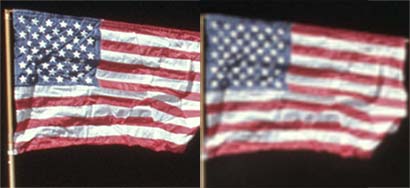A Review of Serif PanoramaPlus 1

Which Flag Do You Prefer? Before and After Using Serif PanoramaPlus 1
I was in a local bookstore last week going through the magazine section and pulled the current issue of the astronomy magazine BBC Sky at Night. I'm in the habit of going through all the astronomy magazines in search of interesting articles. Unfortunately for Sky at Night I've never came across an article in their magazine that would make it worth its price. Looking at the May 2007 issue, it wasn't what was inside the magazine that grabbed my interest but what was on the CD that comes with the magazine.
The CD has a full version of Serif's PanoramaPlus, version 1. This program automates the creation of panoramic images given a list of individual source images. Previously I had created my panoramas by using Adobe Photoshop's Transform Tool and layer masks. Needless to say the Transform Tool is definitely suboptimal – especially when it comes to altering the geometry of the individual images. While I wasn't thrilled that as a part of the software activation process I had to call the UK offices of Sky at Night, I figured that would be cheaper than going out and buying the software. What bugged me about this is that for all other magazines containing CDs with full versions of software being offered, I've never had to make a phone call to activate the product: either it was ready to go or all I had to do was point my browser at the specified web page to complete the registration.
Fortunately the software did have a one time use without registering so that I could fire it up and test it out. I fed the program a total of 11 images from an Apollo 16 EVA to merge. Their combined file size was 8.5 megabytes. PanoramaPlus quickly stitched them together and as far as I could tell from the software's preview window, had done a good job of it.
The final step was to export the newly created panorama. Therein lies the source of my disappointment. The only export format available was to save as a jpeg. Not only that but there was no option to specify image quality and no documentation identifying what compression setting the software was using. The other shock was the size of my new panorama – just 3000 pixels wide. PanoramaPlus had taken 11 separate images with a combined width of 25,740 pixels and combined file size of 8.57 megabytes and created a panorama just 3000 pixels wide with a file size of 880K.
As a before and after comparison I took the American flag from the panorama and enlarged it to match the flag in one of the source images. The comparison of the two flags is shown at the top of this article. Note that the image shown is a scaled down version of the full size comparison. On the left is the original source flag image and on the right is the flag image from the PanoramaPlus panorama, upsized to match the size of the original flag. The qualitative difference is obvious.
Going to the Serif web site, I see that they are now on version 3 of the software so it is probably no longer the same product. Bottom line: if you're thinking of buying the May 2007 issue of Sky at Night because of the PanoramaPlus version 1 software, don't – big mistake. And the special upgrade offer they are running in the magazine: if you're in the U.S. and paying in U.S. dollars, the standard price for the software is cheaper than the Sky at Night special “discount.”
Ad Astra, Jim
| Return to the Blog Index | This entry was posted on Wednesday, May 23rd, 2007 at 11:47 amand is filed under Digital Art, Digital Photography, Graphics Software, Photoshop.
2 Responses to “A Review of Serif PanoramaPlus 1”
-
PanoramaPlus uses an engine called “Autostitch” (fthe basic engine is available at http://www.photo-freeware.net/autostitch.php), which i have been using for some time, and recommend heartily. It's pretty basic in that form, but works well.
I haven't tried the Serif product, but the basic engine has a number of settings under “EDIT” -> “Options” that you can tinker with, including specifying the width (or height) of the output file and JPG quality (default there is 75, but you can change it). Having used other Serif products (their DTP, PagePlus, in particular) in the past, it would surprise me greatly if PanoramaPlus were any less functional…
-
Hi Mike,
I too have used Autostitch and can also recommend it – especially since it not only works well but is free.
As to PanoramaPlus, the version 1 software was a big disappointment to me and it was less functional than Autostitch.
Call me foolish but subsequent to the original post, and in spite of my dissatisfaction with version 1, I did go out and buy version 3. It is far better than version 1 in that you can create full size versions of your panorama and have options as to the format for saving.
I'm still not fully satisfied with either the user interface or its ability to assemble panoramas and may one day purchase another product to see if I can get better results.